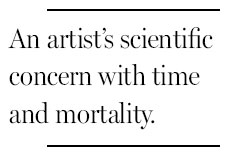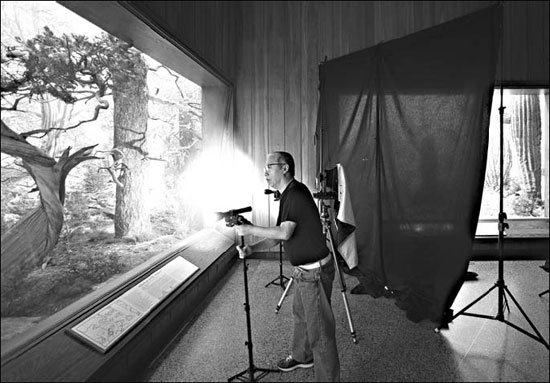Photographer creates his own reality
Updated: 2012-10-21 08:02
By Randy Kennedy(The New York Times)
|
|||||||
|
Hiroshi Sugimoto started photographing dioramas at the American Museum of Natural History in New York decades ago. Fred R. Conrad / The New York Times |
In a corner of his airy studio, Hiroshi Sugimoto maintains a kind of private natural history museum, a paring from the immense collection of artifacts he has amassed since becoming one of the art world's most successful photographers.
There is a speckled shard of moon rock, a soccer-ball-size chunk of iron meteorite that fell in Namibia, and fossilized dinosaur eggs that look like props from the movie
"Alien."
Mr. Sugimoto's work grapples with questions of perception and photography's claims to truth. But his interests have always reached further, to an almost scientific concern with time and its inconvenient companion, mortality.
Among the first pictures that brought this Japanese-born photographer acclaim were ones of dioramas at the American Museum of Natural History in New York that he began more than 30 years ago. The photographs were, in a sense, nature twice removed - once by the naturalist's rifle and the taxidermist, the second time by
Mr. Sugimoto's large-format camera.
He compares the work to successive stages of fossilization. And on a moderately crowded weekday morning not long ago, Mr. Sugimoto was out fossilizing again, in the museum's inky-dark Hall of North American Forests. It was the first time in more than two decades that he had returned to the dioramas to continue working through an idea that won't leave him alone.
The series has often focused on animals - polar bears, musk oxen, African antelope, ostriches - that come off, in his stark black-and-white translations, as surreal, tricking the eye more effectively than the dioramas themselves into believing that they are images of nature taken on the Serengeti or in the Arctic.
But this time, Mr. Sugimoto, 64, has directed his attention to plant-and-tree-dominated dioramas that present what he sees as a vision of the earth after most complex animal life has disappeared, a relatively brief interlude on the planet's 4.5 billion-year calendar.
"Maybe it is my age," he said. "I'm starting to take a very long view." He gestured out the window. "In 100 years, if we weren't here, this whole city would start to look like a forest again."
Mr. Sugimoto - whose work is now on view in London at the Pace Gallery - picked nine new dioramas to shoot at the natural history museum.

Weaving through patrons, his assistants erected tall frames for black curtains that cloaked the dioramas, to eliminate reflection on the glass. Then Mr. Sugimoto set up his beloved R. H. Phillips and Sons 8x10 camera and took Polaroid film test shots.
Everyone on his team wore Halloween ninja costumes to eliminate the possibility of reflection from the museum's spotlights.Holding up a black pole, Mr. Sugimoto energetically waved a placard attached to the top of the pole during the length of the three-and-a-half-minute exposure, to "dodge" down the brightness of the clouds.
In his ninja suit, he said, jokingly: "I'm inviting the spirits into my photography. "It's an act of God."
Elisabeth Sussman, a curator and photography expert at the Whitney Museum of American Art, which includes Mr. Sugimoto's work in its collection, said that his pictures have always worked at "extremes between this kind of Buddhist meditativeness and an incredible formal control."
Mr. Sugimoto said he continued to return to the museum - and to other natural history museums around the world - in part because he sees something in them, a realer-than-real, that he is able to capture a little better each time. "I'm trying to make it as close as possible to my wished vision of what it should look like," he said.
In his New York studio a few days earlier, he showed off an auction catalog of new items on his wish list. The auction was for ancient torture devices, including a spiked neck ring.
"I collect weird things," Mr. Sugimoto said. "And I make weird things."
The New York Times
(China Daily 10/21/2012 page12)
